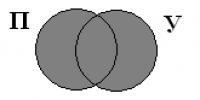American model of a market economy presentation. Presentation on the topic "American model of quality management"
Type of economy The United States is characterized by a mixed type of economic system. distinctive features: priority of market organization of the economy; multi-sectoral economy; public entrepreneurship is combined with private entrepreneurship with its full support; orientation of state financial, credit and tax policies towards economic growth and social stability; social protection of the population.

The Role of the Government in the US Economy: The Most Important Role of the Federal government authorities is that they control the overall pace of economic activity, trying to ensure continuous economic growth, high level employment and stable prices. By changing government spending and tax rates (fiscal policy) or by managing the money supply and controlling the use of credit (monetary policy), they can slow or speed up economic growth and simultaneously influence price and employment levels .


According to data for February 2009, the average time to search for a job in the United States remained unchanged compared to the previous month and was almost 20 weeks or 5 months. However, the distribution of the number of unemployed people by duration of unemployment has changed. Consequently, in general, in February 2009, the state of the labor market in the United States worsened, as the increase in the number of unemployed was accompanied by an increase in the duration of the job search period. In 2007, GDP per capita in the United States increased by $397, or 1.1%, over the previous year and was equal to $US in real terms.

Conclusion Modern market economy mixed type today, it appears to be the most perfect system that has ever existed. Its main feature is that it successfully combines the features of completely different economic systems: pure capitalism and command economy, although the features of pure capitalism predominate. It is most adapted to changing internal and external conditions, i.e. flexible.

Slide 2
…. History of development ….
Today, there are three main national schools in management: Japanese European American Let us dwell in more detail on the American model. The study of the American management model is of some interest. It was in the USA that the science and practice of management was first formed. The American management model originated in turn of the 19th century
– 20th century, when the United States was experiencing an economic boom.
Slide 3
The founder is Henri Fayol. The American model is used in corporations in the UK, USA, Australia, New Zealand, Canada and some other countries. It is characterized by the presence of individual shareholders and an ever-increasing number of independent, i.e., non-corporate shareholders (called “outside” shareholders or “outsiders”), as well as a clearly developed legal framework defining the rights and responsibilities of three key participants
Slide 4
Participants in the American model are: managing directors shareholders (mainly institutional investors) government agencies exchanges self-regulatory organizations consulting firms providing consulting services to corporations and/or shareholders on issues of corporate governance and proxy voting
Slide 5
What makes the American management model successful? In the American school of management it is generally accepted that the success of a company depends, first of all, on internal factors
. Particular attention is paid to the rational organization of production, constant growth of labor productivity, and efficient use of resources. While external factors fade into the background.
includes many stages.
The basis of management is
system and situational analysis external environment(macroenvironment and competitors) constant analysis of the internal (research and development, personnel and their potential, finance, organizational culture, etc.) environment.
Slide 8
The most important integral part The planned work of the corporation is strategic planning, which arose in conditions of market saturation and the slowdown in the growth of a number of corporations. Strategic planning creates the basis for making effective management decisions. To reduce workers’ resistance to organizational changes taking place in corporations, programs are being developed to improve the “quality of working life”, with the help of which corporation employees are involved in developing a strategy for its development, discussing issues of rationalization of production, and solving various external and internal problems. The first concerns the strategic decisions of the company, which determine the main directions of its functioning. After developing the latter, the company makes operational decisions to adapt its activities to unforeseen circumstances (equipment breakdown, defects, etc.) and to changes in the market situation.
Slide 9
Specifics of management in American companies. Peculiarities of mentality.
Slide 10
Management in American companies
Currently, four main forms of involving workers in management have become widespread in the United States: participation of workers in managing labor and product quality at the shop level; creation of works councils (joint committees) of workers and managers; development of profit sharing systems; attracting worker representatives to corporate boards of directors. Involving workers in participation in the highest corporate management bodies - boards of directors - is extremely rare in practice.
Slide 11
Main features of management in an American company:
Functionality, which means clearly assigned job responsibilities to the employee. Principle: Focus on what you do best; It doesn’t matter what you are, what matters is what you can do as a specialist. The manager's task is to unleash the creative potential of the employee. Encouraging new ideas. Mandatory retraining and continuous training. Management by objectives. Dissection of any problem where the solution is associated with a set of heterogeneous knowledge. A clear algorithm for achieving. Implementation of opposite trends: a rigid functional approach (for example, a conveyor system) and a large number of leaders and creative individuals, decentralization and centralization, rigidity in defending one’s interests and flexibility in implementation. Career growth occurs strictly within the framework of professional specialization. Developed corporate culture.
“Property and Entrepreneurship” - The actual use of a thing. Leading place in a market economy. Relationship between people. Xenophon. Peculiarities. The essence of entrepreneurial activity. Individual. A complete bundle of rights. Number of participants. Acquisition of a controlling stake. Shareholder ownership. Ownership.
“Market relations in the economy” - Stock market. Economic systems. Free competition market. The proportion of exchange of goods for money. Monopoly. Correlation between m/y concepts. Markets by type of competition. Change in the quantity of demand. Types of markets. Market economy. Market mechanism. Competition. Quantity of demand. Market features. Plan. Offer.
“Models of economic systems” - German model of a mixed economy. Swedish model of mixed economy. Traditional economics. General scheme of a mixed economy. Command-administrative economy. Advantages market economy. Mixed economy. Mixed economy models. Types of economic systems. Conditions for the functioning of a market system.
“Mixed economic system” - Shadow economy. Today the mixed economy is an integral system. Mixed economy. Mixed economy. Factor income. Main features. A way of organizing economic life. Mixed economic system. Multi-layered character. Mixed economy of developed countries. Private sector.
“Economic systems and their types” - Three ways to solve basic economic issues. A way of organizing economic life. Table. What is an economic system. Method of decision making. Advantages. Economic system. Money. Advantages and disadvantages. Types of economic systems. A way of organizing the economic life of society.
“Modeling of economic systems” - Stages of development. Material balances. Model of rational bank behavior. Mathematical modeling of economic systems. Banking system. Ecomod system functions. Calculation results. Initial representations. Economics of independent state enterprises. Economy of the period of financial stabilization.
There are 18 presentations in total
“Property and Entrepreneurship” - The actual use of a thing. Leading place in a market economy. Relationship between people. Xenophon. Peculiarities. The essence of entrepreneurial activity. Individual. A complete bundle of rights. Number of participants. Acquisition of a controlling stake. Shareholder ownership. Ownership.
“Market relations in the economy” - Stock market. Economic systems. Free competition market. The proportion of exchange of goods for money. Monopoly. Correlation between m/y concepts. Markets by type of competition. Change in the quantity of demand. Types of markets. Market economy. Market mechanism. Competition. Quantity of demand. Market features. Plan. Offer.
“Models of economic systems” - German model of a mixed economy. Swedish model of mixed economy. Traditional economics. General scheme of a mixed economy. Command-administrative economy. Advantages of a market economy. Mixed economy. Mixed economy models. Types of economic systems. Conditions for the functioning of a market system.
“Mixed economic system” - Shadow economy. Today the mixed economy is an integral system. Mixed economy. Mixed economy. Factor income. Main features. A way of organizing economic life. Mixed economic system. Multi-layered character. Mixed economy of developed countries. Private sector.
“Economic systems and their types” - Three ways to solve basic economic issues. A way of organizing economic life. Table. What is an economic system. Method of decision making. Advantages. Economic system. Money. Advantages and disadvantages. Types of economic systems. A way of organizing the economic life of society.
“Modeling of economic systems” - Stages of development. Material balances. Model of rational bank behavior. Mathematical modeling of economic systems. Banking system. Ecomod system functions. Calculation results. Initial representations. Economics of independent state enterprises. Economy of the period of financial stabilization.
There are 18 presentations in total
The main features of the modern American economic model are:
unconditional priority of private property; strong competition; flexible labor and product markets;
insignificant government regulation (with legislative restrictions on the possibilities of government intervention);
relatively low taxes;
shareholder capitalism, which stimulates the extraction of maximum profits;
strong social differentiation.
Liberal market economy (USA)
IN social sphere The liberal model presupposes the creation of equal opportunities for everyone, but the results of activity depend only on the economic entities themselves and on the circumstances.
The state regulates the operation of the market, but the government's efforts are aimed at providing the country with public goods (national defense, etc.).
The economy is based primarily on private property, market principles are respected, but the state pays more attention to equalizing not only the opportunities for entrepreneurial activity, but also equalizing the results of this activity, i.e. income.
The degree of income redistribution is high, hence the high level of taxation. The share of government spending in the gross national product is quite high, and the state budget is of significant size.
Social market economy (Europe)
On the one hand, this helps reduce the wealth stratification of people, making society more consolidated and less differentiated. On the other hand, a high level of taxation slows down economic growth and reduces interest in effective work.
The higher the level of government regulation, the inevitably stronger the bureaucracy, as a result of which the economic mechanism becomes less flexible.
High unemployment is also a consequence of developed social support: high wages and taxes reduce the incentive of firms to hire more workers, high unemployment benefits reduce incentives to look for work.
A national economic system based on private ownership and adherence to basic market principles, but with very significant government intervention in the functioning of the market.
Taxes are very high, but so are various social benefits. Accordingly, social differentiation of the population is less than in other developed countries, including European ones. There is a certain level of unemployment
Model of “Scandinavian socialism”
A distinctive feature of the Scandinavian model is the significant role not only of the state, but also of various public organizations, for example, trade unions, in regulation economic processes. Relations between employers and employees are regulated at the national level.
This model has such disadvantages as inflexibility, low motivation for entrepreneurial activity, etc.
These shortcomings are mitigated by such a feature of the Scandinavian countries as a very low (perhaps the lowest in the world) level of corruption in the state apparatus.
Japanese economic model
Private property is of fundamental importance, and the role of the state, if measured by the share of state ownership, or the size state budget relative to gross internal product, is extremely insignificant.
While formally remaining independent, economic entities pay great importance interaction with your partners, competitors, and other entities. Government regulation in such conditions, it takes the form mainly not of direct instructions, but of advice, recommendations, consultations, to which subjects listen.
Japanese economic model
The state, on the one hand, supports competition between entities, but on the other hand, pays no less attention to cooperation between them. The economy is based on market motivations, but the strategies of the subjects are very long-term in nature.
The pursuit of short-term, quick profits, characteristic of the flexible liberal model of the American economy, is replaced by the desire for long-term stable development in the Japanese model. Long-term, promising projects are being implemented well, but a flexible response to a rapidly changing market situation is difficult.
Chinese model
Cannot be classified as a model entirely based on market principles. This is a mixed economy, but rather with the dominance of socialist principles of state regulation.
Stormy influx foreign investment, the development of private property and market relations - all this is characteristic of China, but a developed state apparatus is also characteristic, regulating most processes of economic activity.
Chinese model
There is significant regional differentiation - new market enterprises are concentrated in certain regions, while others still live in a socialist regime.
China is developing towards a market economy in its own specific way.



